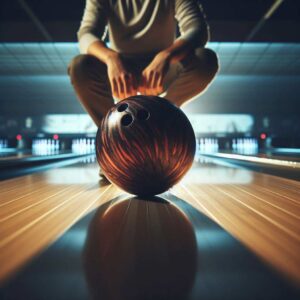If you’re just starting out in the world of bowling, having the right ball in your hands can make a huge difference in your accuracy, control, and overall performance on the lanes. As a beginner, selecting your first bowling ball might seem like an overwhelming task, with the multitude of options available.
However, by understanding the key factors that go into a bowling ball’s construction and performance, you’ll be better equipped to choose a ball that perfectly suits your needs and sets you up for success.
This comprehensive guide will cover everything a beginner needs to know when selecting their first bowling ball. We’ll dive into the different components that make up a ball, explore the various performance characteristics, and highlight some of the most popular options specifically designed for those new to the sport.
By the end, you’ll have all the knowledge you need to confidently make an informed decision and invest in a ball that will serve you well as you embark on your bowling journey.
Bowling Ball Construction
At the core (pun intended) of every bowling ball lies its unique construction, which directly impacts its performance on the lanes. The three main components that make up a ball’s anatomy are the coverstock, core, and weight block.
-
Coverstock
The coverstock is the outer shell or “skin” of the bowling ball, and it plays a crucial role in determining the ball’s overall reaction on the lane. There are three primary coverstock materials:
- Plastic/Polyester: These entry-level coverstocks are inexpensive and provide a straighter roll with minimal hook potential, making them ideal for beginners who are still developing their release and haven’t built up much rev rate (spin/rotation) on their shots.
- Urethane: Urethane coverstocks offer more traction than plastic, allowing for a moderate hook potential. They are a popular choice for those seeking a bit more backend movement without the aggressive hook of reactive resin balls.
- Reactive Resin: These performance coverstocks are highly responsive to oil patterns and friction, enabling a strong backend hook motion. While they offer impressive scoring potential, reactive resin balls require more experience and rev rate to control effectively.
-
Core
The core is the dense inner component of the bowling ball, and its design plays a significant role in the ball’s overall motion and dynamics. There are three main core types:
- Pancake Core: These cores are tall and thin, promoting an earlier roll and more length before the ball starts to transition or hook. Pancake cores are often found in balls designed for straighter trajectories.
- Symmetrical Core: Symmetrical cores provide a balanced and predictable motion path, making them a popular choice for many entry-level and benchmark balls.
- Asymmetrical Core: Asymmetrical cores create more flare potential and backend movement, allowing the ball to rev up more easily. While they offer impressive scoring potential, they also require more experience and release consistency to control effectively.
-
Weight Block
The weight block refers to the dense materials (usually metals like tungsten or bismuth) used to bring the bowling ball up to its desired weight. The positioning and distribution of this weight block within the core can influence the ball’s overall dynamics and motion characteristics.
Ball Weight
In addition to construction, another crucial factor to consider when selecting a bowling ball is its weight. Most bowling balls range from 6 to 16 pounds, with the majority of adults using balls between 14 and 16 pounds for optimal pin-carrying potential.
As a beginner, it’s generally recommended to start with a lighter ball weight until you build up the strength and consistency in your release. A good rule of thumb is to choose a ball that’s around 10% of your body weight, give or take a pound or two. For example, if you weigh 150 pounds, a 14 or 15-pound ball might be a suitable starting point.
It’s also important to ensure that the finger and thumb holes are properly sized and spanned (the distance between holes) to fit your hand comfortably. An improperly fitted ball can lead to discomfort, poor release, and potential injury over time.
Ball Reaction
One of the primary considerations for beginners when choosing a bowling ball is its overall “reaction” or motion behavior on the lane. This reaction is influenced by factors such as the coverstock material, core design, and the individual’s rev rate (ball rotation).
In general, beginner bowlers tend to have lower rev rates and less overall hand-to-ball coordination early on. As such, it’s often recommended to start with a ball that offers a more predictable and controllable motion, rather than an aggressive hooking reaction that can be more difficult to manage.
- Straight Balls: Balls with plastic or polyester coverstocks, coupled with a pancake or symmetrical core, tend to roll straighter down the lane with minimal hook potential. These types of balls are often referred to as “straight” or “entry-level” balls and are well-suited for beginners who are still developing their release and technique.
- Hooking Balls: As you progress and build up more rev rate, you may eventually want to transition to a ball with more hooking potential. Balls with reactive resin coverstocks and asymmetrical cores are designed to create more backend movement and hook action, enabling more striking power and versatility on different lane conditions.
Popular Beginner Ball Options
With an understanding of the key construction and performance factors, let’s take a look at some of the most popular beginner bowling ball options on the market:
Plastic/Polyester Balls:
- Brunswick Rhino: A longtime favorite, the Rhino is a classic plastic ball that offers a reliable, predictable roll with minimal hook potential.
- AMF Rubicon: Another highly affordable plastic ball option, the Rubicon is a great starting point for those on a tight budget.
- Pyramid Path Rising: With its durable polyester coverstock, the Path Rising is a step up from basic plastic balls while still providing a controlled, straight trajectory.
Entry-Level Reactive Resin Balls:
- Storm !Q Tour: This ball features Storm’s iconic R2S Pearl Reactive coverstock, offering a bit more backend responsiveness than plastic balls while remaining relatively tame for beginners.
- Roto Grip Hustle: The Hustle series from Roto Grip is a popular entry-level reactive ball line that provides a manageable hook potential at an approachable price point.
- Ebonite Maxim: With its solid reactive coverstock and symmetrical core, the Maxim strikes a nice balance between hook and control, making it a suitable option for progressing beginners.
Choosing Your Ball
With the various construction and performance factors in mind, as well as some popular beginner ball options to consider, how do you go about actually selecting the perfect first ball for your needs? Here are some key points to keep in mind:
- Budget: Beginner bowling balls can range anywhere from $50 for basic plastic/polyester options, up to $150 or more for entry-level reactive resin models. Determine your budget upfront and focus your search within that range.
- Skill Level: As a complete novice, it’s generally advisable to start with a more affordable plastic or polyester ball that offers a straight, predictable roll. As your skills and rev rate improve, you can then consider transitioning to a ball with more hooking potential.
- Future Progression: While you may be tempted to go with the most inexpensive option, it’s worth considering a ball that offers a bit more versatility and room for growth as your skills develop. Entry-level reactive resin balls can be a worthwhile investment for beginners looking to progress beyond the straight ball stage.
- Get Fitted: Once you’ve narrowed down your options, it’s highly recommended to visit a local pro shop and get professionally fitted for your ball. An experienced driller can ensure that the finger and thumb holes are properly sized, spanned, and positioned for your specific hand and release style, maximizing comfort and consistency.
- Research and Reviews: Take advantage of online resources, such as product reviews, comparisons, and bowling forums, to gain insights from experienced bowlers on the various ball options and their performance characteristics. This can help you make a more informed decision based on your individual needs and preferences.
Ball Maintenance and Care
Regardless of the bowling ball you ultimately choose, proper maintenance and care are essential to ensure its longevity and continued peak performance. Here are some key tips for taking care of your new ball:
- Cleaning: After each use, it’s important to clean your bowling ball thoroughly to remove any built-up oil, dirt, or debris. Use a certified ball cleaner and a soft cloth or ball cleaning pad to gently scrub away any residue. Avoid using harsh chemicals or abrasives that could damage the coverstock.
- Resurfacing: Over time, the coverstock of your ball will become worn and less responsive due to repeated use and friction on the lanes. To restore its performance, it’s recommended to have your ball resurfaced (also known as “re-souring”) by a professional pro shop operator. This process involves carefully sanding or abrading the coverstock to renew its traction and restore the ball’s intended reaction characteristics.
- Storage: When not in use, store your bowling ball in a dry, temperature-controlled environment, away from direct sunlight or extreme heat/cold. This will help prevent warping, cracking, or other damage to the coverstock and internal components.
- Handling: Always use a ball cup or carry case with a secure finger grip when transporting your ball. Avoid dropping or mishandling the ball, as impacts can cause internal damage to the core or coverstock over time.
- Know When to Replace: Even with proper care and maintenance, bowling balls have a finite lifespan. If your ball develops cracks, becomes severely gouged, or loses its intended reaction despite resurfacing, it may be time to consider replacing it with a new model.
By following these simple maintenance practices, you can help ensure that your beginner bowling ball continues to perform at its best and provides you with an enjoyable, consistent experience on the lanes for years to come.
Conclusion
Choosing the right bowling ball as a beginner is an important first step in developing your skills and maximizing your enjoyment of this engaging sport. While the multitude of options may seem overwhelming at first, understanding the key construction elements, performance factors, and popular ball models designed specifically for new bowlers will help guide you toward a selection that perfectly suits your needs.
Remember, as a novice, it’s generally advisable to start with a more affordable plastic or polyester ball that offers a straight, predictable roll. This will allow you to focus on developing proper technique and building up your rev rate before potentially transitioning to a ball with more hooking potential down the line.
Don’t be afraid to seek guidance from experienced bowlers or pro shop professionals, either. Getting properly fitted and taking advantage of their expertise can ensure you select a ball that is not only well-suited to your current abilities but also offers room for growth as your skills progress.
Most importantly, have patience and enjoy the journey of improving your game, one roll at a time. With the right bowling ball in hand and a commitment to practicing proper form, you’ll be knocking down strikes and spares with confidence in no time.
Whether you’re looking to join a league, bond with friends and family, or simply find a new hobby to stay active and engaged, bowling offers a lifetime of enjoyment and challenges to conquer. So grab that perfectly suited beginner ball, lace up your shoes, and let the good times roll!





